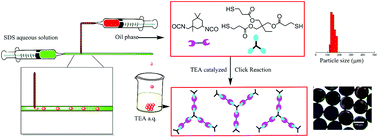Water-borne thiol–isocyanate click chemistry in microfluidics: rapid and energy-efficient preparation of uniform particles†
Abstract
A nucleophile-catalyzed thiol–isocyanate reaction has been exploited as an efficient route to fabricate uniform particles in a water-borne system. Droplets were generated in a simple microfluidic setup from stoichiometric thiol and isocyanate monomers, thereby creating an oil-in-water emulsion, and polymer particles were obtained once the monomer droplets were exposed to a nucleophile. This is the first report of thiol–isocyanate polymerization in a water-borne system, which shows great promise in the manufacture of particles for its mild conditions, rapid rate and high conversion. Notably, heat, UV, anhydrous or oxygen-free conditions are not required. It is demonstrated that particles with sizes ranging from 40 to 250 μm can be prepared via adjusting the flow rate of continuous and disperse phases. In addition, the functionality of the thiol monomer has a profound effect on the morphology of particles. This method opens up possibilities for nucleophile-catalyzed thiol–isocyanate click chemistry in water-borne and heterogeneous polymerization.


 Please wait while we load your content...
Please wait while we load your content...